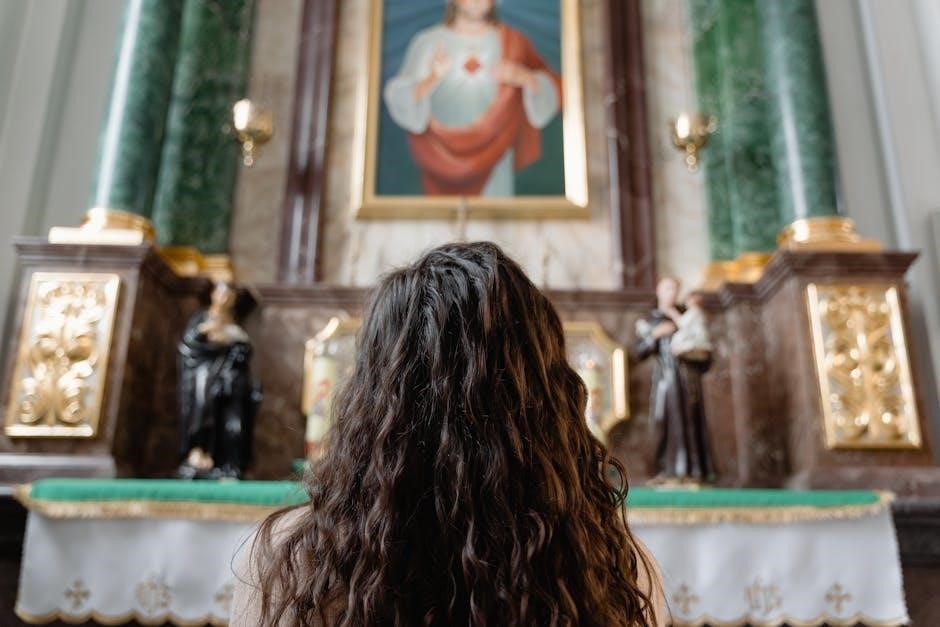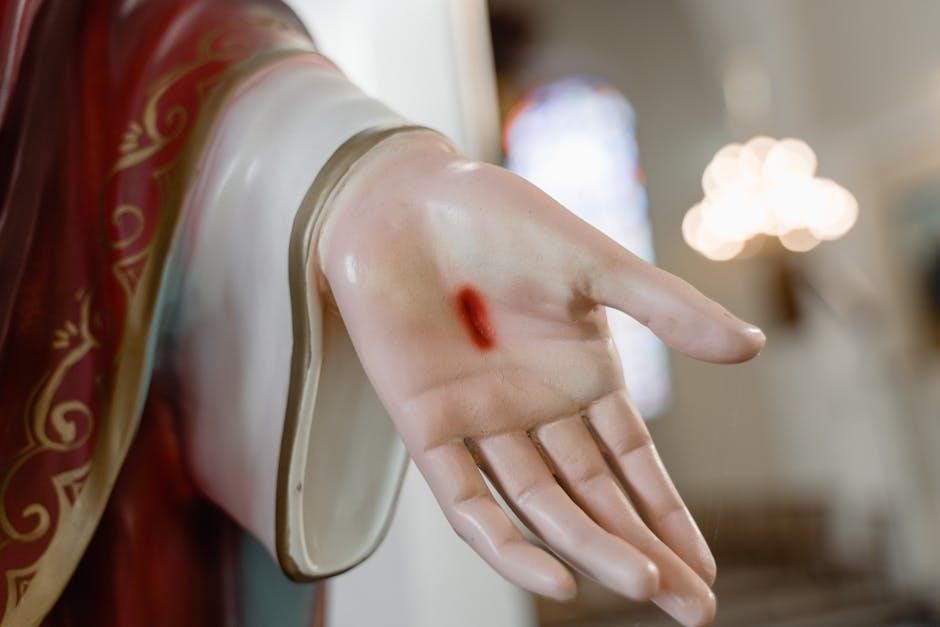
chaplet of the five wounds of jesus pdf
The Chaplet of the Five Wounds is a traditional Catholic devotion honoring Jesus’s crucifixion wounds․ Composed of five groups of five red beads, it symbolizes His blood shed for humanity․ Each section represents one wound, fostering meditation and prayer for spiritual healing, with prayers approved by the Holy See in 1823․
1․1 Historical Background and Significance
The Chaplet of the Five Wounds traces its origins to the 18th century, deeply rooted in Catholic devotion to the Passion of Christ․ It was popularized by St․ Alphonsus Liguori, a prominent theologian and founder of the Redemptorists, who emphasized the spiritual value of meditating on Christ’s wounds․ The chaplet gained official recognition on August 11, 1823, when it was approved by the Holy See, further cementing its place in Catholic tradition․ Over time, Pope Leo XII simplified its structure to make it more accessible to the faithful while retaining its indulgences․ Historically, the chaplet has been a powerful tool for reflecting on Christ’s sacrifice and seeking spiritual healing․ Its significance lies in its focus on the redemptive power of Christ’s blood and wounds, which are seen as a source of mercy and forgiveness for humanity․ This devotion remains a vital part of Lenten and Passion-focused prayer practices;
1․2 Purpose and Spiritual Benefits
The Chaplet of the Five Wounds is a devotional prayer designed to honor the sacrifices of Christ and seek spiritual healing through His passion․ Its primary purpose is to meditate on the five wounds Christ endured during His crucifixion, reflecting on their redemptive power․ By praying this chaplet, the faithful seek to draw closer to Christ, expressing gratitude for His suffering and asking for the grace to amend their lives․ The chaplet is believed to offer spiritual benefits such as the remission of sins, the cleansing of one’s soul, and the strengthening of faith․ It also serves as a means to implore God’s mercy and pardon, with a focus on the healing power of Christ’s wounds․ The devotion is particularly emphasized during Lent, as it aligns with the Church’s meditation on the Passion of Christ․ Through this prayer, believers seek to deepen their relationship with Jesus and find solace in His divine mercy․

Structure and Components of the Chaplet
The Chaplet of the Five Wounds consists of five sections, each with five red beads symbolizing Christ’s blood․ Medals representing His wounds are included, and prayers like the Glory Be and Hail Mary are recited․
2․1 Overview of the Chaplet’s Design
The Chaplet of the Five Wounds is a devotionally rich prayer tool designed to honor Christ’s five wounds from the Crucifixion․ It typically consists of five groups of five red beads, symbolizing the blood shed by Jesus․ Each group represents one of the five wounds: the left foot, right foot, left hand, right hand, and the Sacred Heart․ The chaplet often includes medals or crucifixes depicting these wounds, serving as focal points for meditation․ The structure is simple yet profound, with each bead inviting the practitioner to reflect on Christ’s suffering and sacrifice․ The use of red beads emphasizes the blood shed for humanity’s redemption, while the arrangement of the chaplet facilitates a systematic and contemplative prayer experience․ This design makes it accessible for devotees to pray and meditate on the Passion of Christ, fostering a deeper connection to His sacrifice․
2․2 The Five Sections and Their Meaning
The Chaplet of the Five Wounds is divided into five distinct sections, each corresponding to one of the wounds Jesus Christ endured during His Crucifixion․ The first section represents the wound in Jesus’ left foot, inflicted during the nailing to the cross․ The second honors the wound in His right foot, symbolizing stability and endurance․ The third and fourth sections focus on the wounds in His left and right hands, respectively, signifying His divine sacrifice and humanity’s redemption․ The fifth section meditates on the wound in Jesus’ Sacred Heart, pierced by the lance, which is a symbol of divine love and mercy․ Each section is designed to guide the faithful in contemplating the depth of Christ’s suffering and the profound spiritual significance of His sacrifice․ By praying through these sections, devotees can reflect on the redemption brought by each wound, deepening their understanding of Christ’s love and mercy․

Prayers and Meditations
The Chaplet includes the Glory Be and Hail Mary prayers for each section, focusing on Christ’s wounds․ Meditations reflect on His suffering, while the concluding prayer seeks healing and mercy through His sacrifice․
3․1 The Glory Be and Hail Mary in Each Section
Each section of the Chaplet of the Five Wounds includes the recitation of the Glory Be and Hail Mary prayers․ On the small beads, one Hail Mary is prayed, while the Glory Be is recited on the larger beads․ This structure emphasizes devotion to the Blessed Virgin Mary and the Holy Trinity․ The prayers are intertwined with meditations on Christ’s wounds, fostering a deeper connection to His sacrifice․ Additionally, the large beads feature a specific prayer: “Eternal Father, I offer Thee the Wounds of Our Lord Jesus Christ to heal the wounds of our souls․” This prayer seeks divine mercy and healing through the merits of Christ’s suffering․ The combination of these prayers creates a rhythm of praise, petition, and reflection, making the Chaplet a powerful tool for spiritual growth and devotion․
3․2 Meditations on Each of the Five Wounds
The Chaplet of the Five Wounds includes meditations on each of Christ’s wounds, inviting the faithful to reflect on His passion and sacrifice․ Each section corresponds to a specific wound: the left foot, right foot, left hand, right hand, and the sacred heart․ As one prays the Hail Mary and Glory Be, they meditate on the suffering endured by Jesus․ The left foot represents humility, the right foot signifies perseverance, the left hand embodies patience, and the right hand symbolizes compassion․ The sacred heart, pierced by the lance, stands for divine love and mercy․ These meditations deepen one’s understanding of Christ’s sacrifice and encourage personal conversion․ By focusing on each wound, the devotee connects with the emotional and spiritual pain of Jesus, fostering empathy and gratitude․ This reflective practice enhances the prayer’s efficacy, offering a profound encounter with the crucified Lord․
3․3 Concluding Prayer and Its Importance
The Concluding Prayer of the Chaplet of the Five Wounds is a powerful invocation that summarizes the devotion․ It begins with the words, “O Lord Jesus Christ, who at the sixth hour of the day didst mount the gibbet of the cross and shed Thy precious blood for the redemption of the world․” This prayer emphasizes Christ’s ultimate sacrifice and invites the devotee to reflect on the profound love demonstrated through His wounds․ The prayer concludes with a plea for mercy and the grace to amend one’s life, making it a heartfelt expression of gratitude and repentance․ The Concluding Prayer is essential as it unites the devotee with Christ’s passion, fostering spiritual healing and a deeper commitment to following His teachings․ It serves as a final act of surrender, sealing the intentions and meditations of the Chaplet and offering them to God․ This prayer is a beautiful culmination of the devotion․

Spiritual Benefits and Indulgences
The Chaplet of the Five Wounds offers profound spiritual benefits, including emotional healing, forgiveness, and a deeper connection to Christ’s sacrifice․ It grants indulgences, as approved by the Holy See, fostering devotion․
4․1 Indulgences Granted by the Holy See
The Chaplet of the Five Wounds has been granted indulgences by the Holy See, recognizing its profound spiritual value․ These indulgences, approved in 1823, offer remission of temporal punishment for sins․ Devotees who recite the chaplet with devotion gain these blessings, reflecting the Church’s endorsement of its efficacy in fostering piety and contrition․ The indulgences emphasize the chaplet’s role in drawing believers closer to Christ’s passion, encouraging a deeper appreciation of His sacrifice․ By praying the chaplet, the faithful can attain spiritual cleansing and grace, aligning with the Church’s teachings on redemptive suffering․ This sacred practice, enriched by indulgences, continues to inspire devotion and spiritual growth among Catholics worldwide․
4․2 Emotional and Spiritual Healing Through the Chaplet
The Chaplet of the Five Wounds is a powerful instrument for emotional and spiritual healing․ By meditating on Christ’s wounds, devotees connect with His suffering, fostering empathy and compassion․ This reflection often brings solace to those burdened by emotional pain or spiritual distress; The practice encourages believers to seek healing through Christ’s sacrifice, emphasizing His love and mercy․ Prayers like the Hail Mary and Glory Be, combined with meditations on the wounds, create a sense of peace and renewal․ Many find comfort in the chaplet’s structure, which provides a routine for processing grief or seeking spiritual restoration․ The focus on Christ’s passion helps believers transcend their struggles, drawing strength from His endurance․ This devotion not only heals emotional wounds but also deepens one’s relationship with God, offering hope and consolation in times of need․ Its timeless appeal lies in its ability to address both the heart and the soul․
4․3 Strengthening Faith and Devotion
The Chaplet of the Five Wounds is a profound means of strengthening faith and devotion․ By focusing on Christ’s sacrificial love, believers deepen their understanding of His divine mercy and the redemption He offers․ Regular recitation fosters a closer relationship with Jesus, encouraging a life rooted in gratitude and humility․ The chaplet’s meditative nature helps believers reflect on the depth of Christ’s suffering, renewing their commitment to His teachings․ Prayers such as the Glory Be and Hail Mary reinforce devotion, while meditations on the wounds inspire a greater appreciation for Christ’s Passion․ This devotion also encourages believers to imitate Christ’s virtues, such as patience and forgiveness, in their daily lives․ Over time, the chaplet becomes a transformative practice, nurturing spiritual growth and a deeper connection to the Church’s traditions․ It serves as a powerful tool for revitalizing faith and fostering a lifelong dedication to following Christ․

Theological Significance
The Chaplet of the Five Wounds emphasizes Christ’s sacrificial love and divine mercy․ It symbolizes the unity of His Passion with humanity’s salvation, reflecting the depth of redemption through His blood․
5․1 Symbolism of the Number Five
The number five in the Chaplet of the Five Wounds holds profound theological significance․ It represents the five wounds Christ endured during His crucifixion—two in His hands, two in His feet, and one in His side․ This number is not merely a count but a sacred symbol that encapsulates the entirety of Christ’s sacrifice․ The wounds are often seen as a manifestation of God’s love and mercy, each one a testament to the depth of His suffering for humanity’s redemption; The chaplet’s structure, with five sections of five beads each, mirrors this sacred number, inviting the faithful to reflect deeply on each wound and its spiritual implications․ Through this numerical symbolism, the chaplet becomes a powerful tool for meditation, connecting the devotee with the central mystery of Christianity—Christ’s Passion and Resurrection․
5․2 Representation of Christ’s Sacrifice
The Chaplet of the Five Wounds profoundly represents Christ’s sacrifice through its focus on the physical and spiritual wounds He endured during His crucifixion․ Each wound—those in His hands, feet, and side—symbolizes the depth of His suffering and love for humanity․ The chaplet serves as a visual and meditative reminder of the sacrifice that redeemed the world․ By meditating on these wounds, devotees connect with the mystery of Christ’s Passion, reflecting on the profound act of love that each wound embodies․ The chaplet’s structure, with its five sections, mirrors the five wounds, creating a tangible link between the devotion and the historical event of the crucifixion․ This representation invites the faithful to contemplate the sacrifice and its enduring significance in their spiritual journey, fostering a deeper understanding of Christ’s redemptive love․ The chaplet thus becomes a powerful instrument for uniting the believer with the sacred mystery of Christ’s sacrifice․

Practical Guide to Recitation

The Chaplet of the Five Wounds is recited using five groups of five beads, each group representing one of Christ’s wounds․ Begin with the Eternal Father prayer, followed by a Glory Be and Hail Mary for each bead, meditating on the corresponding wound․ Conclude with a final prayer to seal the devotion․ Proper meditation and focus on the wounds enhance the spiritual experience․
6․1 How to Pray the Chaplet Step-by-Step
To pray the Chaplet of the Five Wounds, begin by making the sign of the cross․ The chaplet consists of five groups of five beads, each representing one of Christ’s wounds․ Start with an Eternal Father prayer on the large bead, offering Christ’s wounds for the healing of souls․ On each of the five small beads, recite one Glory Be and one Hail Mary, meditating on the specific wound associated with that group․ After completing the five beads, move to the next group and repeat the process․ Conclude the chaplet with a final prayer, such as the Concluding Prayer, which invokes Christ’s mercy and grace․ Proper meditation on each wound enhances the spiritual benefits of this devotion․ Ensure a reverent and focused approach to deepen your connection with Christ’s sacrifice․
6․2 Proper Meditation for Each Wound
Proper meditation on each of the five wounds of Christ is essential for fully embracing the spiritual depth of the chaplet․ Begin by reflecting on the wound in Jesus’ left foot, symbolizing His steadfastness in enduring suffering for humanity․ Next, meditate on the wound in His right foot, representing His willingness to carry the cross for our salvation․ The wound in His left hand reminds us of His sacrifice and the nails that bound Him to the cross, while the wound in His right hand signifies His divine mercy and forgiveness․ Finally, the wound in His sacred heart embodies the immense love He poured out for all souls․ Reflecting on these wounds helps deepen your connection to Christ’s passion and fosters personal healing․ Focus on the spiritual significance of each wound to enhance your devotion and draw closer to God’s grace․

Cultural and Devotional Impact
The Chaplet of the Five Wounds holds deep cultural and devotional significance, particularly during Lent․ It symbolizes Christ’s sacrifice and is often accompanied by the red rose, representing His blood and wounds․
7․1 Role in Lenten Devotions
The Chaplet of the Five Wounds plays a significant role in Lenten devotions, serving as a powerful tool for reflection on Christ’s Passion․ During Lent, Catholics often use this chaplet to meditate on the suffering and sacrifice of Jesus, fostering a deeper spiritual connection․ The focus on the five wounds—hands, feet, side, and the two from the crown of thorns—reminds believers of the physical and emotional pain endured by Christ for humanity’s salvation․ Many pray the chaplet during Stations of the Cross or on Good Friday to intensify their Lenten observance․ Its structure, with five sections of five beads, encourages a rhythmic and contemplative prayer experience, aligning with the somber and reflective atmosphere of the Lenten season․ This devotion helps believers to unite their own sacrifices and penance with Christ’s ultimate sacrifice, enriching their spiritual journey toward Easter․
7․2 Use as a Devotional Tool
The Chaplet of the Five Wounds is a powerful devotional tool for fostering spiritual growth and deepening one’s connection with Christ’s Passion․ Its structure, comprising five sections of five beads, allows for a focused and meditative prayer experience․ Each section represents one of Jesus’s wounds, inviting the faithful to reflect on His sacrifice and the redemption it offers․ The chaplet is often used to seek healing, both spiritual and emotional, as it emphasizes the merits of Christ’s wounds for the salvation of souls․ Its portability and simplicity make it accessible for daily prayer, encouraging believers to integrate it into their routine devotions․ By meditating on the wounds, individuals can cultivate gratitude for Christ’s love and sacrifice, while also seeking strength to bear their own trials․ This devotion is particularly cherished for its ability to bring comfort and deepen faith, making it a meaningful tool for personal and communal prayer․

Key Figures and Influences
St․ Alphonsus Liguori played a significant role in popularizing the Chaplet of the Five Wounds, while Pope Leo XII simplified its recitation and retained its indulgences, enhancing its accessibility for devotees worldwide․
8․1 St․ Alphonsus Liguori’s Contribution
St․ Alphonsus Liguori, a prominent 18th-century Catholic saint and theologian, played a pivotal role in popularizing the Chaplet of the Five Wounds․ He composed a little chaplet dedicated to the wounds of Jesus, emphasizing their spiritual significance and the merits of praying for healing through them․ His work, approved by the Holy See in 1823, structured the chaplet into five sections, each representing one of Christ’s wounds․ Alphonsus encouraged devotees to meditate on these wounds while reciting prayers, such as the Glory Be and Hail Mary, fostering a deeper connection to Christ’s Passion․ His writings and endorsements significantly contributed to the chaplet’s widespread use, making it a powerful tool for seeking spiritual healing and indulgences․ Through his efforts, the Chaplet of the Five Wounds became a cherished devotion, inspiring countless believers to reflect on the sacrifice of Jesus and the redemptive power of His suffering․
8․2 Pope Leo XII’s Simplification
Pope Leo XII played a crucial role in simplifying the Chaplet of the Five Wounds, ensuring its accessibility and widespread use among the faithful․ Recognizing the devotion’s deep spiritual value, he streamlined its structure and prayers, retaining the essential elements while making it easier to recite․ This simplification allowed believers to focus more on meditation and less on complex rituals, enhancing the chaplet’s appeal․ His modifications included standardizing the prayers and emphasizing the indulgences attached to its recitation․ By doing so, Pope Leo XII ensured that the chaplet remained a meaningful yet approachable devotion, fostering a deeper connection to Christ’s Passion without overwhelming practitioners․ His efforts were instrumental in preserving the chaplet’s integrity while adapting it to the needs of the faithful, ensuring its enduring relevance in Catholic spirituality․ Through his leadership, the Chaplet of the Five Wounds continued to be a source of comfort and grace for many․

Resources and Availability
The Chaplet of the Five Wounds is widely available in PDF format online, offering detailed prayers, meditations, and step-by-step guides․ Many Catholic websites provide free downloads, making it accessible for devotion․
9․1 Accessing the Chaplet PDF
The Chaplet of the Five Wounds is readily available in PDF format, accessible through various Catholic websites and religious resources․ Many official Catholic portals offer free downloadable versions, ensuring widespread accessibility․ These PDFs typically include the complete prayers, meditations, and step-by-step instructions for recitation․ They also feature illustrations of the Five Wounds and relevant scriptural references, enhancing devotion․ Some versions are accompanied by historical context and theological significance, deepening understanding․ The PDFs are often designed for personal use, making them ideal for printing or digital viewing․ Additionally, they are frequently available in multiple languages, catering to a global audience․ With a simple internet search, devotees can easily locate and download the Chaplet of the Five Wounds PDF, enabling them to engage in this meaningful prayer practice wherever they are․ This convenient format ensures that the Chaplet remains a accessible tool for spiritual reflection and worship․